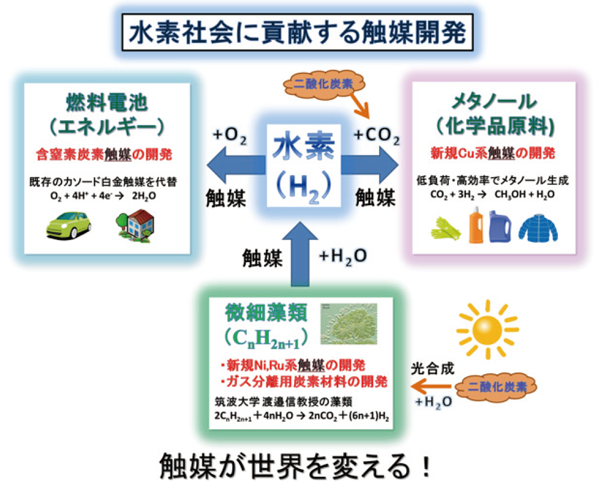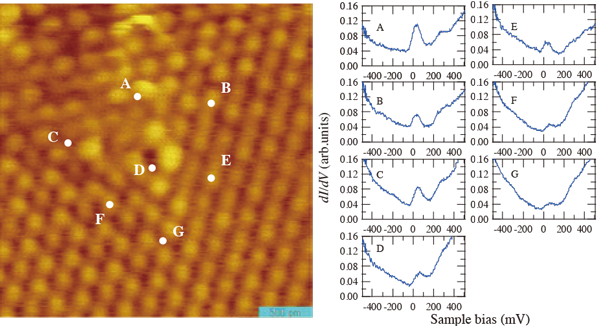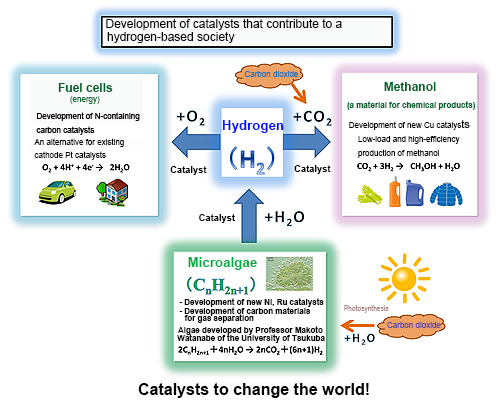他のメンバー : 一戸 雅聡 岡田 晋 丸本 一弘 久保 敦 近藤 剛弘 桑原 純平 後藤 博正 山本 洋平 守友 浩 初貝 安弘 小林 航 小林 正美 神原 貴樹 神田 晶申 西村 賢宣 藤田 淳一 鍋島 達弥 百武 篤也 木島 正志 櫻井 岳暁
キーワード: 環境・エネルギー、CO2 削減、元素戦略、触媒、炭素利用
http://www.ims.tsukuba.ac.jp/~nakamura_lab/ http://www.tsukuba-greeninovn.org/
 人の活動に伴って排出される二酸化炭素(CO2)は世界的に増加の一途をたどっています。また、CO2 を排出しない水素社会の構築がここ数年強く叫ばれています。本リサーチユニットは、未来に負担を負わせずに高度な科学技術を実現する社会を支えるために、触媒機能を利用してエネルギーをいかに産み出すかを念頭において活動しています。白金(Pt)などの貴重資源の使用を抑え、試行錯誤ではなく科学的な設計指針に基づいて安価で安全な元素からなる触媒を研究開発していこうとしています。
人の活動に伴って排出される二酸化炭素(CO2)は世界的に増加の一途をたどっています。また、CO2 を排出しない水素社会の構築がここ数年強く叫ばれています。本リサーチユニットは、未来に負担を負わせずに高度な科学技術を実現する社会を支えるために、触媒機能を利用してエネルギーをいかに産み出すかを念頭において活動しています。白金(Pt)などの貴重資源の使用を抑え、試行錯誤ではなく科学的な設計指針に基づいて安価で安全な元素からなる触媒を研究開発していこうとしています。
水素社会を支える高効率触媒の研究開発
CO2 の排出を抑制するには、高生成効率・低生成エネルギーの観点から、CO2 を水素と反応させてメタノールにするのが最も現実的で合理的な考えです。一方、水素(H2)燃料電池を使うことによりCO2 を排出することなく水(H2O)を排出することで、地球規模で負担の少ない社会を実現することができます(図1 参照)。現在過剰に存在するCO2 を削減し、新しい燃料電池システムを実現するためには、いずれも水素を必要としています。CO2 からメタノール合成するためには、CO2 を触媒表面で活性化させる必要があります。そのために、水素原子を表面に吸着させた銅(Cu)表面にCO2 超高速分子線を衝突させることで、対称性の高いCO2 を活性化して最終的にメタノールに変換する研究を進めています。触媒開発はこれまで試行錯誤的な研究開発に陥ってしまうのが通例でしたが、本リサーチユニットでは、計算科学と表面科学の知識を融合させて物理化学の基礎を確立した上で、工学的な技術を社会に提供しようという研究に重きをおいています。

図1:水素社会に貢献する触媒研究の概念
燃料電池への水素利用と藻類を利用した水素製造

図2: N 含有グラフェンのSTM 像とSTS スペクトル(STM: 走査トンネル顕微鏡、STS:走査トンネル分光法)
自動車、家庭でのエネルギー源として燃料電池が広く使われだしています。現在はカソード電極触媒としてPt が使われていますが、低価格化、希少資源の有効活用の観点から、π電子系炭素利用の研究を進めています。窒素を含有させたグラフェン(C 原子1 層からなる物質)やナノカーボンのエッジ効果を利用しようとするものです。本来なら非常に均一な電子状態をもつグラフェンが、図2 のようにN 原子などが作る欠陥周囲で原子毎に異なる電子状態をもつことを見出しました。まだ化学的性質が明らかにされていないカーボンナノ構造を基礎的に理解したうえで新しい触媒を開発しようとしています。また、メタノール合成、燃料電池で利用する水素は、筑波大学で先進的な研究をしている藻類から作ることを考えています。
従来の科学技術は、基礎科学(シーズ)、応用研究、実用化研究、実用というフローで進められてきましたが、変化が速く、競争の激しい現代社会の中では、社会に受容されることを必要な要素として基礎研究を進めることが要求されています。本リサーチユニットでは、産業界・社会での実用に必要な課題を取り入れつつ、できるだけ早く実用化に移行できる基礎研究を産業界とも連携して進めています。
社会への貢献・実績
- CO2 還元ワークショップの開催 2015 年3 月13 日
- アルカリドープグラファイトにおける無磁場下のランダウ準位
(Nature Communications, Vol. 3, 2012.) - ヘテロダインSTS の開発 (Scientific Reports, 4, 6711, 2014.)
- 県民大学「ナノグリーンイノベーション」2015 年5 月~ 8 月 茨城県県南生涯学習センター
取材:平成27年7月31日
New catalysts to address CO2-related issues and establish a hydrogen-based society
Unit members : Ichinohe, Masaaki Okada, Susumu Marumoto, Kazuhiro Kubo, Atsushi Kondo, Takahiro Kuwabara, Junpei Goto, Hiromasa Yamamoto, Yohei Moritomo, Yutaka Hatsugai, Yasuhiro Kobayashi, Wataru Kobayashi, Masami Kanbara, Takaki Kanda, Akinobu Nishimura, Yoshinobu Fujita, Jun-ichi Nabeshima, Tatsuya Momotake, Atsuya Kijima, Masashi SAKURAI, TAKEAKI
Unit name: Nano Green
Key words: environment/energy, CO2 reduction, element strategies, catalysts, utilization of carbon
 The amount of CO2 emitted around the world as a result of people’s activities is continuing to increase. In recent years, it has become increasingly necessary to develop a CO2-free hydrogen-based society. With the aim of supporting the Japanese society in which advanced scientific technologies can be developed without increasing the burden on future generations, the research unit focuses on the generation of energy utilizing catalytic functions. Members of the unit promote the research and development of catalysts composed of inexpensive and safe elements based on the scientific design guidelines, rather than through trial and error, while avoiding the use of platinum (Pt) and other valuable resources.
The amount of CO2 emitted around the world as a result of people’s activities is continuing to increase. In recent years, it has become increasingly necessary to develop a CO2-free hydrogen-based society. With the aim of supporting the Japanese society in which advanced scientific technologies can be developed without increasing the burden on future generations, the research unit focuses on the generation of energy utilizing catalytic functions. Members of the unit promote the research and development of catalysts composed of inexpensive and safe elements based on the scientific design guidelines, rather than through trial and error, while avoiding the use of platinum (Pt) and other valuable resources.
Research and development on high-efficiency catalysts to support a hydrogen-based society
The most realistic and rational approach to the reduction of CO2 emissions from the viewpoints of high generation efficiency and the reduction of required energy is to facilitate the reaction of CO2 with hydrogen to generate methanol. Furthermore, the use of hydrogen fuel cells, which emit H2O, rather than CO2, will contribute to the development of environmentally friendly societies at a global level (Figure 1). Hydrogen is required to both reduce the excessive amount of CO2 in the atmosphere and develop new fuel cell systems. To facilitate methanol synthesis using CO2, it is necessary to activate CO2 on the surface of a catalyst. Hydrogen atoms are adsorbed to the surface of copper (Cu) and ultrafast CO2 molecular beams are applied to it to activate CO2 with a highly symmetric structure and convert it into methanol. Although research and development on catalysts often rely on trial-and-error approaches, the research unit aims to integrate knowledge obtained from the fields of computational and surface science to establish physicochemical foundations, and provide society with engineering technologies based on them.

Figure 1. Concept of research on catalysts that contribute to a hydrogen-based society
Utilization of hydrogen for fuel cells and the generation of hydrogen using algae

Figure 2. An STM image of an N-containing graphene and its STS spectrum (STM: scanning tunneling microscopy, STS: scanning tunneling spectroscopy)
Fuel cells are becoming increasingly popular as energy sources for automobiles and at home. Pt is used as a cathode electrode catalyst at present, and there has also been progress in research on the utilization of π electronic carbons from the viewpoints of price reduction and effective utilization of scarce resources. The research aims to utilize the edge effects of graphen (a substance consisting of a layer of carbon (C) atoms) to which nitrogen is added and nano carbon. The research unit has confirmed that, although the electronic state of graphen is significantly homogenous, the state differs depending on the atoms in perivascular areas, as shown in Figure 2. The research unit aims to develop new catalysts by promoting a basic understanding of carbon nanostructures whose chemical characteristics have not been clarified. The unit plans to generate hydrogen, which is used for methanol synthesis and fuel cells, from algae since the University of Tsukuba has been conducting advanced research on them.
The development of scientific technologies has conventionally been going through the process of basic science (seeds), applied research, practical research, and practical use. However, as the speed of changes increases and competitions become more severe in modern society, it has become increasingly important for people who conduct basic research to place an emphasis on its acceptance by society. The research unit collaborates with industries to conduct basic research, so that the research results can be put into practice smoothly, while addressing problems to promote their application to the industrial world and society.
Social contributions and achievements
- Held a workshop on CO2 reduction on March 13, 2015
- Landau levels in alkali-doped graphite on zero magnetic fields (Nature Communications, Vol. 3, 2012)
- Development of heterodyne STS (Scientific Reports, 4, 6711, 2014)
- “Nano Green Innovation”, a college for people living in the prefecture, May to August 2015, Ibaraki Prefectural Lifelong Learning Center Kenna
Interviewed on July 31, 2015
